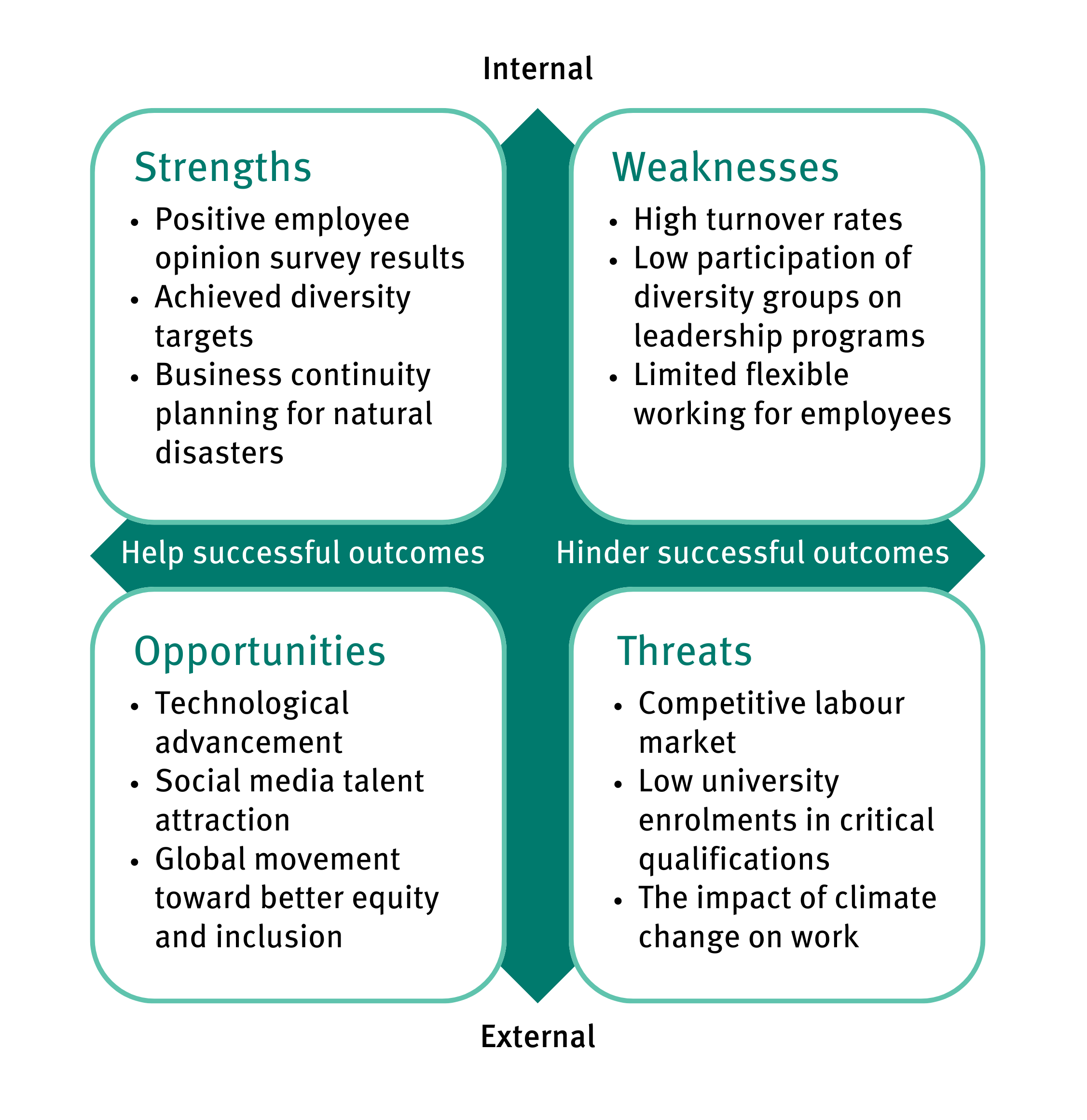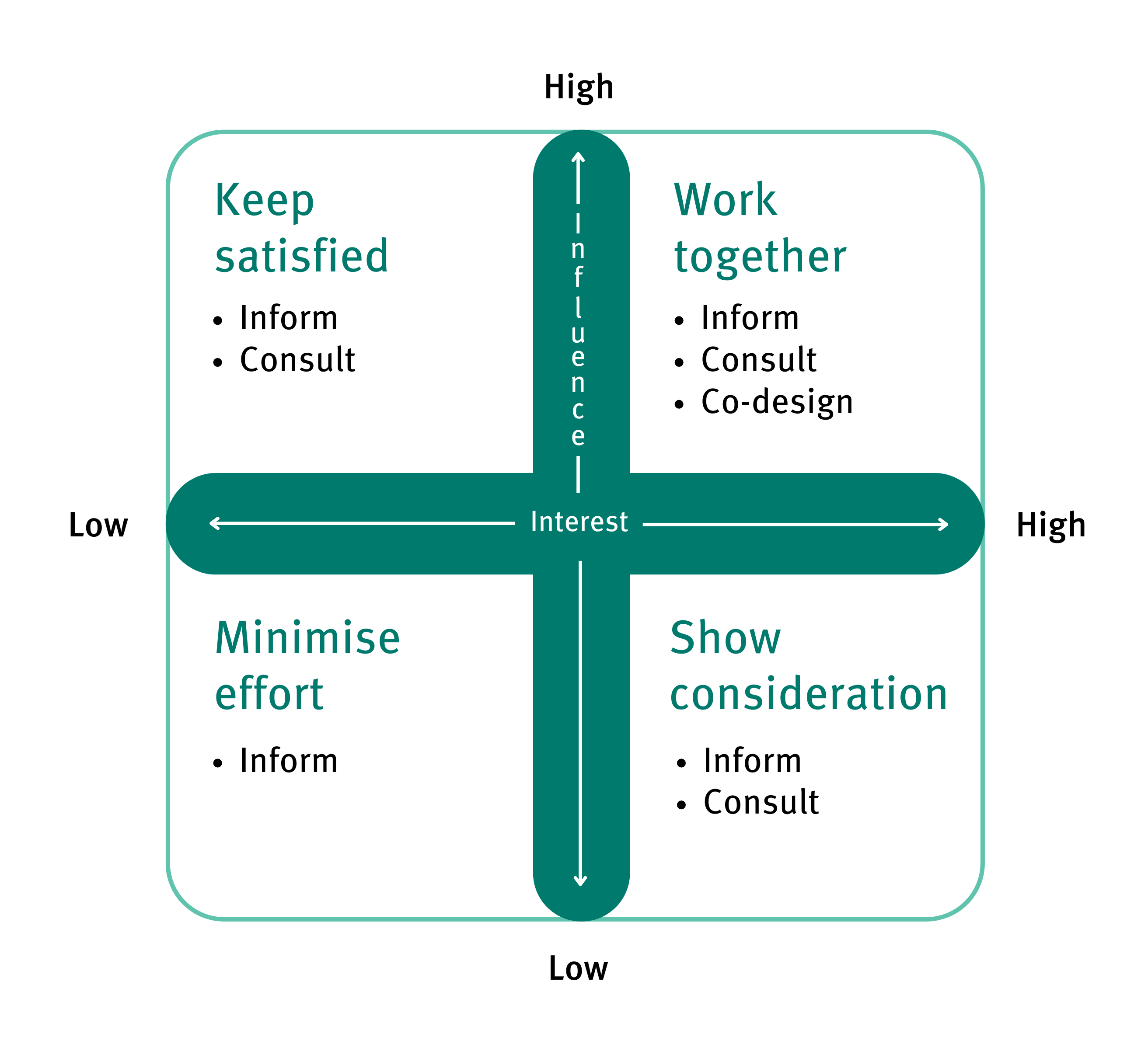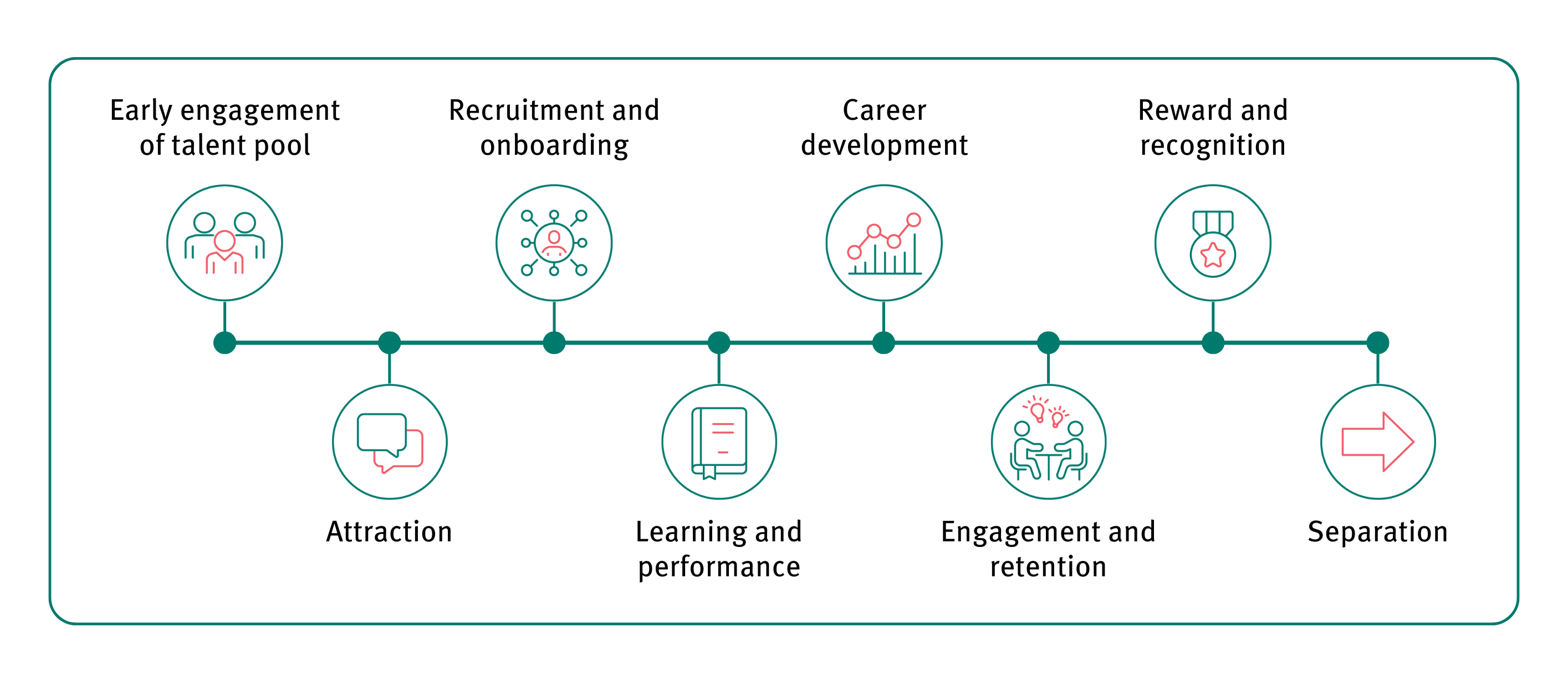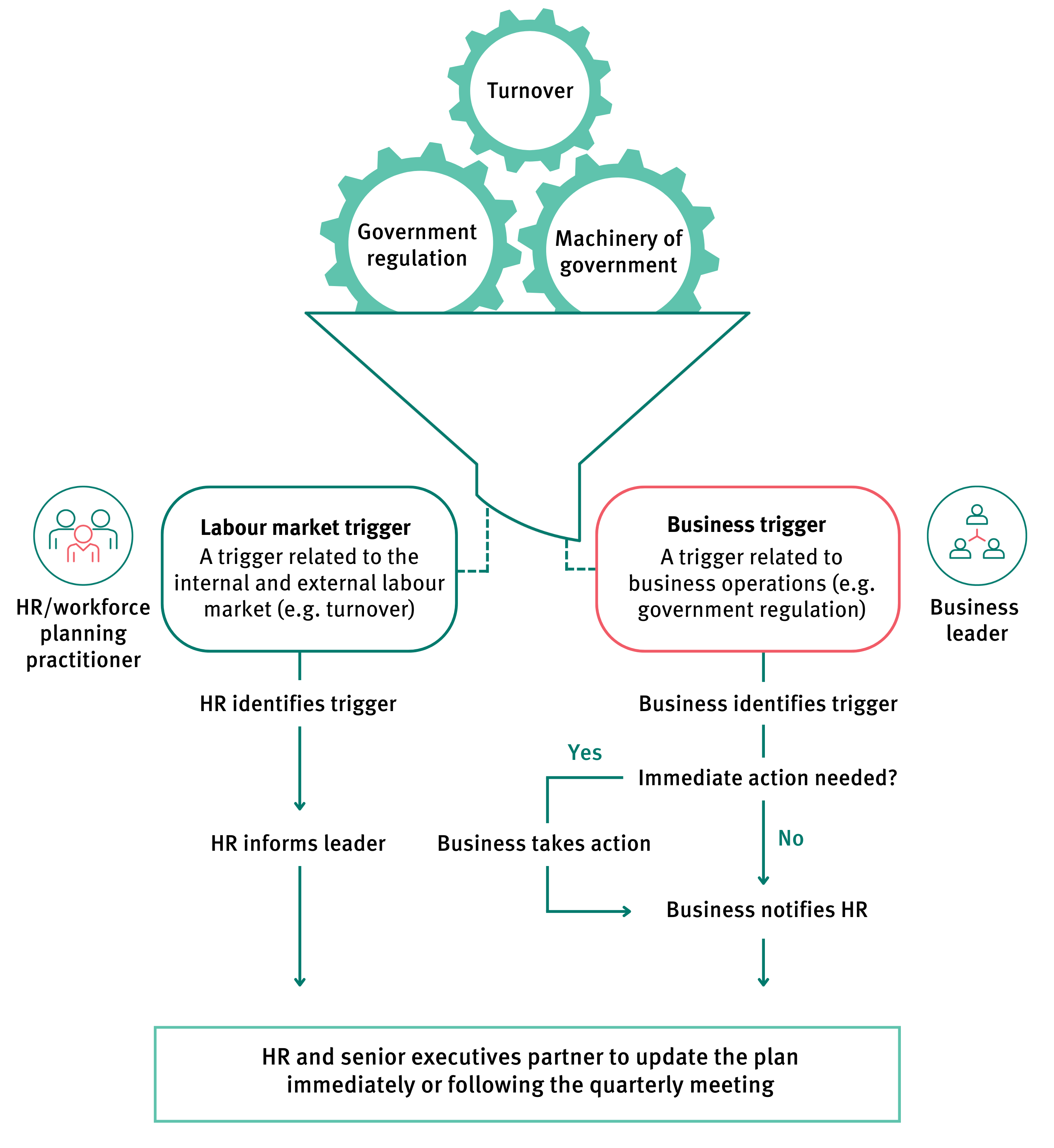Strategic workforce planning
Your agency must have a strategic workforce plan that is updated annually as part of the strategic planning process.
There is no single approach for creating and maintaining a strategic workforce plan. Your approach will depend on your agency’s size, capability mix, risk appetite and specific workforce challenges.
Use the Strategic Workforce Planning: Agency requirements guide and the Strategic workforce planning framework to create a workforce plan that meets your agency’s current and future needs.
Understanding the strategic landscape is crucial for analysing how drivers of change can affect your workforce. This analysis requires a deep dive into the factors both outside and within of your organisation that can have significant impacts.
External factors
An effective external workforce scan includes evaluating historic, current and emerging climates and trends. A PESTEL analysis can be a useful tool to determine the impacts and factors in guiding an organisation’s direction:
- Political influences such as government direction and policy impacts.
- Economic conditions including financial markets and industry demands.
- Social dynamics like population demographics and workplace culture.
- Technological advances, encompassing AI, communication channels, and service delivery methods.
- Environmental issues from sustainability to environmental legislation.
- Legal considerations such as emerging law cases and employment legislation.
Resources that can help with strategic foresight include the CSIRO's "Our Future World" report or thought leadership from the OECD.
Internal factors
Considering internal elements might involve a SWOT analysis to identify strengths, weaknesses, opportunities, and threats (see figure 1). Consult your agency's strategic plan, annual reports, and other corporate documents to gain insights into future priorities and workforce needs.
Figure 1: Swot analysis matrix
Identify and map stakeholders
Strategic workforce planning thrives on effective stakeholder identification to ensure everyone is working towards aligned objectives, leading to efficient resource allocation and risk mitigation.
All staff members, from the chief executive and senior leadership level through to individual contributors, play a unique role in the planning process:
- Executives drive the strategic direction and respond to agency challenges.
- Division or business unit leaders serve as ambassadors of workforce initiatives.
- Middle managers and supervisors lead the initiative implementation within their teams.
- HR or people and culture teams facilitate the process, providing frameworks and insights.
- Program or project teams focused on improved service delivery outcomes or specific operational needs.
- Corporate governance, performance or business planning teams that support the success of the organisation through administration and other core functions.
- Finance, ICT, and facilities teams ensure the necessary infrastructure supports the planning.
- Diverse employee groups offer varied perspectives for a more inclusive approach.
- Sector employees at all levels—as well as key business and industry affiliates, advocates and experts—provide valuable insights into the operating environment of an organisation
Map stakeholders
Mapping stakeholders assists the strategic workforce planning process by understanding the level of influence and interest of stakeholders (see Figure 2) and where you should priorities and invest your engagement and communications efforts.
Figure 2: Stakeholder mapping matrix
Engage and collaborate with stakeholders
Effective stakeholder engagement is key to incorporating both internal and external perspectives to ensure:
- efficiency—clarifying roles leads to efficient execution, enabling stakeholders to work towards specific objectives
- goal alignment—ensuring overall organisational success through contributions from executives, divisional leaders, and stakeholders including Aboriginal peoples and Torres Strait Islander peoples, and people from diverse backgrounds that can provide important insights.
- effective resource allocation—incorporating workforce plans into budgeting ensures divisional and business unit leaders allocate resources effectively
- risk mitigation—involving stakeholders like HR and divisional leaders, identifies and mitigates workforce risks, such as skill shortages or gaps
- clear role—fostering effective communication and collaboration across departments, facilitating goal achievement
- data-driven decision-making—providing essential data and analysis for informed decision-making, enabling stakeholders to make strategic choices
- implementation and monitoring—ensuring successful implementation and ongoing monitoring of initiative
- technology support—providing the necessary technology and infrastructure for effective workforce planning
- employee engagement—ensuring diverse perspectives contribute to a more inclusive and effective planning process
- accountability and reporting—establishing mechanisms for accountability and ensure well-documented workforce planning processes, which is crucial for transparency and reporting to higher management.
Stakeholder engagement strategies might involve the following:
- Educate them on the importance and challenges of workforce planning.
- Stakeholder interviews using targeted questions that provide essential insights for internal analysis.
- Learn from their experiences and insights.
- Tailor the planning process to meet your organisation's unique needs.
- Appoint a senior manager as the champion to drive the process.
- Foster continuous communication to ensure transparency and involvement.
- Manage expectations by clearly communicating goals and updates
- Provide clear feedback and reporting mechanisms to foster greater involvement.
Source: Adapted by agreement from Australian Public Service Commission – Workforce planning guide.
To devise a robust strategic workforce plan, it’s essential to have a clear picture of the current workforce, encompassing skills, capacities, and competencies.
Analyse workforce data
Workforce data analysis informs strategies and ensures that your workforce aligns with the broader organisational objectives. It's the bedrock of decisions regarding workforce composition, skill requirements, and performance measures.
Building a foundation for workforce analysis streamlines both operational and strategic planning, granting leaders a clearer view of workforce metrics and potential risks.
Consider that for larger entities, dedicated workforce reporting and analytics teams can delve into systems and retrieve data insights. For smaller organisations, HR or people and culture teams are often well positioned to take on the task of collating and analysing workforce data.
Types of workforce data
- Quantitative Data: Numerical by nature, this data captures counts and values. Use it to track headcounts, vacancies, turnover, and recruitment timelines.
- Qualitative Data: This non-numerical data offers insights into types and categories such as employee sentiments and feedback from surveys, capability reviews, and focus groups.
Source: Australian Bureau of Statistics
For privacy and confidentiality, it's pivotal to analyse de-identified and anonymised data. Access to this data should align with organisational policies and privacy guidelines.
Use primary data sources
Key internal figures for labour supply and demand emerge from establishment data—detailing budgeted, unbudgeted, and vacant positions—and require collaboration across HR and finance to ensure accuracy.
Segment for deeper insight
Segmenting the workforce by characteristics such as demographics, job level, or qualifications helps to pinpoint skill gaps and areas for improvement. This, in turn, informs capability-building and recruitment strategies. Consistent segmentation rules across the organisation ensure accurate and strategic outcomes.
When defining roles, collaborate with respective business areas for clear alignment with the organisation's direction.
Create a baseline report
A baseline report is a snapshot of both qualitative and quantitative workforce data, aiding in strategic plan evaluation. To be effective, such reports should contain:
- Workforce profiles and capabilities
- Business goals and performance metrics
- Progress on strategy implementation
- Anticipated systems and organisational changes
- Workforce performance data—both numbers (like turnover) and sentiments (like employee feedback)
Set indicators and benchmarks
Lead indicators can predict upcoming trends, while lag indicators offer a retrospective look, quantifying past outcomes. Select these wisely to track and evaluate strategic initiatives over time and against peer data.
Benchmark against publicly available sector data for equity, diversity, and broader workforce trends to gain valuable comparative insights. Established datasets might include the State of the sector report, Workforce statistics reports, Working for Queensland survey results, and Gender pay equity dashboards.
Identify critical functions and roles
It's key to identify and safeguard critical functions and roles to minimise workforce risks focused on sustaining operational and strategic continuity, as well as talent management.
Characterise critical roles by specialisation, impact of vacancy, hiring challenges, extensive successor training needs, and potential negative business effects if the role is unoccupied.
Business sections can tag roles linked to priorities, mission-critical services, essential stakeholder relationships, and activities susceptible to surges in demand, then categorise these on a risk scale.
Critical role categories might include:
- Medium risk: Roles and functions which must be completed under all circumstances
- Essential: Roles and functions which may be suspended for a short time
- Low risk: Roles and functions which can be suspended for an extended period.
Scenario planning
Project various future landscapes to enhance organisational adaptability. Scenario planning is not about pinpointing exact futures but crafting a range of possible outcomes to stay agile and ready.
- Explore multiple futures, stimulating strategic discussions.
- Use gathered strategic intelligence, such as leadership insights and environmental scans, to shape scenarios.
- Understand potential changes in services, technology, and customer needs.
- Decide which scenarios to focus on using organisation-specific risk assessment tools.
Scenario planning accounts for both known pathways and emerging unknowns. It also involves preparing for transitions, should these unforeseen scenarios eventuate (see Table 1).
The known | The unknown |
|---|---|
Build workforce transformation initiatives based on the required workforce to deliver on strategic direction already envisaged and committed. Inputs:
| Build workforce transition initiatives based on the required workforce in various scenarios about what the future could look like. Inputs:
|
Prioritise scenarios
Weigh scenarios based on their likelihood and potential impact to focus your workforce strategy. Apply your organisation's risk framework to these assessments and choose several scenarios to consider, especially in volatile conditions. However, a minimum of two scenarios are recommended:
- the most likely scenario, and
- the ideal desired future state.
If an organisational risk framework is not available, refer to Queensland Treasury’s Guide to risk management (see Table 2) for further information.
| Consequence | |||
|---|---|---|---|
| Likelihood | Minor | Moderate | Significant |
| Unlikely | Low | Low | Medium |
| Possible | Low | Medium | High |
| Likely | Medium | High | High |
Note: All data and practices should conform to organisational guidelines and standards.
Source: Adapted by agreement from Australian Public Service Commission – Workforce planning guide.
Forecasting and planning for your organisation's future workforce is a multifaceted process that involves both understanding the supply and demand dynamics as well as strategic segmentation.
Forecasting workforce needs
Forecasting implies predicting what positions, skills, and capabilities will be required for future success, taking into account available resources.
Exploring workforce supply
Internal Supply Analysis:
- Use workforce data for informed planning.
- Audit skills and capabilities, blending them with workforce demographics.
- Analyse demographics for trends influencing future supply.
External Supply Considerations:
- Pinpoint external market skill shortages.
- Consult recruitment experts for market trends on skills acquisition and hiring difficulty.
- Assess current labour market conditions, availability, and competitiveness.
Assessing workforce demand
Workforce demand involves determining what skills are necessary to meet organisational goals.
Demand Analysis Involves:
- Establishing whether current deliverables are being achieved economically and on time.
- Identifying gaps in capacity or capability.
- Forecasting investment areas for future roles.
Anticipating Shifts in Demand:
- Consider budgetary changes and resource implications.
- Assess possibilities for reducing demand via structural adjustments.
- Align workers' skills with job needs and identify emerging crucial roles.
Conducting workforce scans and modelling
A detailed internal scan against current demand sets a baseline for prospective changes. Scenario planning plays a key role due to the inherent uncertainties in forecasting.
Workforce modelling is a delicate balance—it's affected by numerous variables, including economic factors and migration policies. Begin by assessing broader workforce indicators such as population growth and turnover.
Identifying workforce gaps
Gap Analysis Reveals:
- The disparity between current and future workforce needs.
- The timing and scale of needed skills.
- The potential risks each gap represents.
It encompasses addressing future capabilities, structural shifts, and workforce risks, informed by internal data or comparisons with similar organisations.
Strategic talent segmentation
Strategically dividing talent allows organisations to precisely tailor their HR efforts.
Employment Modes for Talent Acquisition:
- Buy: Recruit talent while aligning spend with the labour market.
- e.g., finance or corporate service leads.
- Build: Develop internal capabilities for roles pivotal to the organisation.
- e.g., research and development.
- Borrow: For short-term needs, bring talent for fixed-term projects.
- e.g., consultants, legal experts.
- Boost: Hasten development with initiatives that open up career opportunities.
- e.g., Aboriginal and Torres Strait Islander career pathways.
- Bind: Retain and reposition critical capabilities.
- e.g., re-skilling for the future.
- Bounce: Restructure to ensure skills relevancy and performance.
- e.g., transition for outsourced functions.
By understanding your current workforce and intelligently forecasting future needs, you create a dynamic planning framework to navigate an ever-changing business landscape.
Source: Adapted by agreement from Australian Public Service Commission – Workforce planning guide.
Effective strategic workforce planning hinges on considered strategies and measurements, centred on collaboration, change management, risk assessment, and clear communication.
Designing workforce strategies: a collaborative approach
- Strategising involves business leaders and stakeholders intimately familiar with the organisation's pulse to ensure alignment and shared ownership.
- Reference the Strategic workforce planning framework and Stakeholder engagement section for a detailed approach and considerations.
- While designing strategies that mitigate risks and bridge workforce gaps, it’s beneficial to draw on whole-of-government strategies and plans to enrich the ideas pool.
- HR teams are pivotal in the design and execution phase, ensuring strategies are aligned with business goals and embrace the entire employee lifecycle (see figure 3)
Figure 3: employee lifecycle
Change management: assessing capacity and timeline
- Determine if your organisation leans towards incremental changes or if it’s poised for more significant shifts.
- Evaluate the organisation's readiness for change and the practicality of timelines for implementation, ensuring that planned changes are sustainable over time.
Managing workforce risks: prioritisation and mitigation
- Prioritise risks according to severity and organisational risk appetite, with a focus on those deemed medium or higher.
- Design mitigation strategies collaboratively, aiming to either reduce the likelihood of risks or lessen their impact.
- Common strategies cover organisational development, training, temporary staffing, industry partnerships, and embracing flexible working models.
- Regularly revisit risks as conditions evolve and ensure new risks are integrated into strategic plans and risk registers.
Implementing workforce strategies: clear direction and accountability
- Activate your workforce strategies as part of a cohesive framework that incorporates identified risks, opportunities, and gap closures.
- Support your strategic workforce plan with a clear implementation plan, including parameters like outcomes, timelines, and responsibilities.
- Govern the strategic workforce plan with organisational procedures, executive endorsement, and chief executive approval.
- Communicate effectively, infusing workforce planning into the organisational culture and clarifying roles and purposes.
Governance responsibilities: accountability and roles
- The highest levels of leadership should endorse and uphold the workforce plan, fostering a culture of shared responsibility.
- HR teams and managers play a role in enactment, but ultimate accountability resides with the agency head and senior leaders, adhering to legislative requirements.
Source: Adapted by agreement from Australian Public Service Commission – Workforce planning guide.
A rigorous review process is essential for evaluating the progress of strategic workforce plans, ensuring alignment with ongoing business strategies, and fostering continuous improvement.
Monitoring progress
Continuous monitoring is a critical activity, not merely a routine check. It serves as:
- An assurance mechanism to confirm that plans are being actioned effectively.
- A progress tracking tool to maintain a real-time view of plan performance.
- A system for proactive adjustments, allowing for prompt responses to deviations.
- A means of maintaining alignment with evolving business goals.
- An approach for optimised resource utilisation and risk mitigation.
Incorporate monitoring into your regular business review cycles to make certain that the strategic workforce and action plans are actively shaping business outcomes.
Reporting regularly to measuring success
An effective review strategy relies significantly on regular reporting using dashboards or other reporting tools which:
- Compare real performance metrics to established targets and benchmarks.
- Provide divisional and regional performance insights in the context of corporate goals.
- Employ leading indicators to preemptively signal emerging risks.
- Deliver granular data analyses for localised management and risk control.
- Trace and evaluate performance trends over time.
- Include projections and forecasts when relevant for forward-looking insights.
Encourage the use of automated reporting tools to distribute crucial information efficiently.
Assess and evaluate impact and outcomes
Engage in periodic, comprehensive evaluations to underpin successful decision-making and enhance organisational performance. A robust evaluation framework should:
- Leverage report data and stakeholder feedback to examine workforce initiatives.
- Review and reaffirm alignment with workforce objectives.
- Measure the effectiveness of strategies to confirm they continue to:
- Match organisational goals and contribute to overall success.
- Provide the necessary workforce capabilities and competencies.
- Effectively manage workloads, employee availability, and skill requirements.
- Support skill development and bridge workforce gaps for operational efficiency.
Adapt for agility
Workforce planning must remain adaptable to respond to the ever-changing organisational environment:
- Plan an annual review cycle, establishing clear evaluation criteria that reflect strategic objectives.
- Involve senior leadership in the planning adaptations.
- Update the organisation on revisions promptly.
- Adjust to acknowledging when plans need change due to evolving internal or external conditions.
- Maintain ongoing vigilance for anything that might necessitate plan updates.
- Incorporate changes into the regular business planning rhythm to maintain focus and avoid overwhelming staff with constant change.
- Document adjustments, capturing new risks and learning to refine strategies moving forward.
- Collaborate, ensuring that all stakeholders, from HR to business leaders, contribute their expertise effectively in response to both labour market and business shifts. Business leaders should focus on business triggers (see Figure 4).
Figure 4: Collaboration in strategic workforce planning
Source: Adapted by agreement from Australian Public Service Commission – Workforce planning guide.
Read the Queensland Government’s 10 year human capital outlook to see how our workforce will change in the coming years. Find out what this means for our work, workplaces and workforce.
Use the 3 year human capital strategic roadmap 2022 to prepare our workforce for a rapidly changing and complex environment. It outlines a pathway for continued workforce transformation across four key levers for change:
- talent acquisition
- leadership and capability
- new ways of working
- culture
Align your agency’s strategic workforce plan with the outlook and roadmap to ensure you’re prepared for the workplace of the future.
For help, contact the Public Sector Commission (PSC) on 07 3003 2830 or at workforcestrategy@psc.qld.gov.au.



